اليازية
Forum Replies Created
-
اليازيةParticipant
 A crab-plover in the same area just before the sunset.. tried to play with the depth of field and kept the bird in a silhouette because I felt the golden light reflected around it will emphasis the importance of the bird.. in reply to: Practice Getting Creative and Telling Stories #739431
A crab-plover in the same area just before the sunset.. tried to play with the depth of field and kept the bird in a silhouette because I felt the golden light reflected around it will emphasis the importance of the bird.. in reply to: Practice Getting Creative and Telling Stories #739431 -
اليازيةParticipant
 I went to a small island to photograph terns.. Got good photos.. but on my way back and just when I reached the shore of the mainland I noticed this Heron fishing.. decided to give it a try and lay down in the middle of the water.. started photographing.. and waited for around 13 minutes till the heron got his fish!
I went to a small island to photograph terns.. Got good photos.. but on my way back and just when I reached the shore of the mainland I noticed this Heron fishing.. decided to give it a try and lay down in the middle of the water.. started photographing.. and waited for around 13 minutes till the heron got his fish!
 in reply to: Practice Getting Creative and Telling Stories #739425
in reply to: Practice Getting Creative and Telling Stories #739425 -
اليازيةParticipant1) The wow moment I felt was during the “Capturing Behaviour” session. When we were asked to sketch as much as we can from the behaviours of birds/animals while watching them for two minutes. Then, drawing a quick sketch within one minute. After that, an extreme sketch of photos within 30 seconds. It was striking to see my 30 seconds then pick one of them to sketch a piece for “Giving Your Drawings Depth” assignment. I was amazed to see the differences between the quick 30 seconds sketch and the proper drawing of more than two hours work. 2) Yes, I have tried two things: A. Imagine your natural subject could talk to you. What would it say? A Conversation between two Sand Bubbler Crabs. Arguing who should leave the hole first.. and one doesn’t want to step out cause he was afraid of the reflection of the sunlight on my iPhone; I placed it there to video the moment it comes - happened for less than 2 seconds only. B. Collect natural items, draw them, and write why you chose each object and where you found them. Collected several types of leaves from the planted trees surrounded us. Printed them on cards to keep a record of what is there by the house. Also, I collected several fallen nests to see what they were built of - guess wha I found! Humans’ hairs, tissue papers, some thin coloured plastics, plant’s roots, feathers, dried leaves, dried grass and extremely thin branches ^_^; ______ Enjoy every moment of while observing the nature , there is always something new to learn ;Din reply to: Tips to Keep You Going #728434
-
اليازيةParticipant
 I did it at last! I tried to go over my fear from watercolours by taking an online course with Ms Molly Murrah "Watercolor 101;" this explains why I'm late ^_^;
I still like my first one.. but I feel satisfied with the 100% watercolour copy. Regardless of the mistakes in the painting style, this is my very first watercolour piece :)
I did it at last! I tried to go over my fear from watercolours by taking an online course with Ms Molly Murrah "Watercolor 101;" this explains why I'm late ^_^;
I still like my first one.. but I feel satisfied with the 100% watercolour copy. Regardless of the mistakes in the painting style, this is my very first watercolour piece :)
 in reply to: See How Far You’ve Come #728325
in reply to: See How Far You’ve Come #728325 -
اليازيةParticipantIt took me ages to answer this question. The reason is that I discovered that we don’t have well-known Arabic author specialising in nature writings. There are some pieces here and there but none could be categorised as nature writer. There was a book on nature I read before - yes the book subject is relative, yet the author is not. The Arabic title is: غريزة أم تقدير إلهي I read it twice.. the rest of the books I have are translated. This made me wonder if it is me who’ve never thought of the subject or is it the publishing industry that doesn’t pay much attention to the topic? Anyways, the book I’m enjoying at the moment is Peter Wohlleben’s The Hidden Life of Trees. I can say it is the sociology of trees’ book!in reply to: The Power of Reflection #728286
-
اليازيةParticipant
 I posted before an attempt to paint a watercolour piece - BUT I spit water one it by mistake !
I didn't want to move forward without posting something here that I'm well satisfied with. So, I followed the video.
I lost control while using the water several times (I don't know why I lose it alway while brushing the right side!) The original plan was to paint the background, however, I forgot that and went straight forward to the bird. Didn't want to take the rest and ruin this piece too. I lost the side fruits as well >.>
in reply to: Filling Your Sketches with Color #720801
I posted before an attempt to paint a watercolour piece - BUT I spit water one it by mistake !
I didn't want to move forward without posting something here that I'm well satisfied with. So, I followed the video.
I lost control while using the water several times (I don't know why I lose it alway while brushing the right side!) The original plan was to paint the background, however, I forgot that and went straight forward to the bird. Didn't want to take the rest and ruin this piece too. I lost the side fruits as well >.>
in reply to: Filling Your Sketches with Color #720801 -
اليازيةParticipantWhile Painting
- The first thing I noticed when comparing my “outdoor sketch” with the photograph is that the horizon line was not right. I corrected my sketch and planned my painting layers ahead before mixing the colours.

- My goal was not the sketch nor the scientific knowledge built from the observation, instead, I was focussing on experimenting with the watercolours and the brushes. I planned four layers: -1- the background; wash the sheet with the required colours and waited till it dried. -2- used dry brush for some parts and add some bright colours for the details. (Then I stopped! I just stopped and I don’t really know why!) Here were the incomplete sketch waited for me:

- The following was the “planned layers” -3- apply the glazing technique for the background and a hint of glazing for the foreground. -4- finally add the details lining and texture.
- HERE IS THE MOST IMPORTANT TIP FROM THIS EXPERIENCE Never move your sketchbook/sheet colours and change your location WHILE painting — a simple thing might happen:

- I full cup of water poured over the painting — I didn’t noticed that until I went back to continue the work. P.S. the water was from the brushes container not a regular cup , I totally forgot to empty it >.<
- now I don’t feel like finishing it — I’ll have to have a better mood or maybe I’ll go back to sketching then I’ll get back to the watercolours (I really really really wanted to finish this piece - it was going to be my first completed watercolour piece)
in reply to: Filling Your Sketches with Color #718848 -
اليازيةParticipantI’ll divide my reply to this discussion into two. First: before painting. Second: while painting. Before painting I went to paint a still-life outdoor, just before the sunset. Although I had all my watercolour set with me, the humidity was high - what I’ve done was to get a quick sketch of what I see. Tried to write a colour code (to paint it indoor) but I thought it won’t be good enough so I took photographs after finishing the sketch. I made sure to have colours of the sky as well as the details. So, I took several shots:

 When I went back inside to paint, I felt I need to create a reference sheet. I sticked with the basic colours only (I know I have ready colours but mixing colours has a much deeper feelings which I liked). The reference sheet was done - and just before that I lost my motive to paint, therefore, I left the sketch for the next morning.
When I went back inside to paint, I felt I need to create a reference sheet. I sticked with the basic colours only (I know I have ready colours but mixing colours has a much deeper feelings which I liked). The reference sheet was done - and just before that I lost my motive to paint, therefore, I left the sketch for the next morning.
 in reply to: Filling Your Sketches with Color #718843
in reply to: Filling Your Sketches with Color #718843 -
اليازيةParticipant
 While working on this entry, I was convinced with one thing: watercolour needs patience. To tame my urgency within myself, I have decided to sketch three sketches at the same time and paint them using watercolours only. By doing so, I was able to create layers for each sketch. After finishing a layer, I moved to the other sketch and do the same. This give me enough time to let the layer dry and experiment as well.
This is my first sketch:
While working on this entry, I was convinced with one thing: watercolour needs patience. To tame my urgency within myself, I have decided to sketch three sketches at the same time and paint them using watercolours only. By doing so, I was able to create layers for each sketch. After finishing a layer, I moved to the other sketch and do the same. This give me enough time to let the layer dry and experiment as well.
This is my first sketch:
 1. The pencil used for the outline sketch was a B6 pencil, I decided to erase it and use a watercolour grey pencil instead. The reason to do so was to avoid erasing any pencil marks after colouring the piece. I was afraid that the eraser would ruin the colours and the sheet.
2. I sticked with the main colours: red, yellow, & blue as well as the white and black. For the base, I mixed the colours on the palette. used a dry on wet for all the sketches.
3. As soon as I felt that the base is dry , I added a bit of lining with the tip of the brush to give an overall colour scheme for the background.
4. After that I waited until it dried fully. Then I used the dry brush to add the details to the texture.
5. I decided to use the white paste with no water at all on a semi-wet brush tip to add a depth to the texture.
6. I tried to add some shades & tones wherever needed as a final step.
This is the second piece:
1. The pencil used for the outline sketch was a B6 pencil, I decided to erase it and use a watercolour grey pencil instead. The reason to do so was to avoid erasing any pencil marks after colouring the piece. I was afraid that the eraser would ruin the colours and the sheet.
2. I sticked with the main colours: red, yellow, & blue as well as the white and black. For the base, I mixed the colours on the palette. used a dry on wet for all the sketches.
3. As soon as I felt that the base is dry , I added a bit of lining with the tip of the brush to give an overall colour scheme for the background.
4. After that I waited until it dried fully. Then I used the dry brush to add the details to the texture.
5. I decided to use the white paste with no water at all on a semi-wet brush tip to add a depth to the texture.
6. I tried to add some shades & tones wherever needed as a final step.
This is the second piece:
 I can’t upload the third one. I did one deadly mistake - I was lazy to mix and find the colour I want for the final detail lining - I ruin it with a blue instead of a dark/grey-purple.
(I lost my patience at the last minute! >.> ) in reply to: Getting Comfortable with Watercolor #716699
I can’t upload the third one. I did one deadly mistake - I was lazy to mix and find the colour I want for the final detail lining - I ruin it with a blue instead of a dark/grey-purple.
(I lost my patience at the last minute! >.> ) in reply to: Getting Comfortable with Watercolor #716699 -
اليازيةParticipantI’ve been avoiding watercolours for ages - there were attempts to get into it but I never produced something good by itself; i had to add ink or other medium to feel good-. This is my reference sheet. I experiment with the brush that mini-water-container, the regular brush, with paste watercolour and cubes water colour. Each has its own feeling. While mixing colour, I found it interesting to see the results on the sheet. I wasn’t satisfy with the tone mixing, I felt there was something wrong with the grey. However, after I left the sheet, went away, and came back I was fully satisfied with the tone and tint. Looking at the shades, I think my hesitation is visible n all of the shades, most probably I had fear of ruining the colour with the black - and so I did ruin the sheet because I brushed over it twice or more. I guess this is a very sensitive medium, if i’m to use it I have to understand all my tools’s pros and cons; that goes for the brushes, colours, sheets and the WATER - yes, I need to understand how the water interacts with the tools. I fell in love with the brush which has been recommended for the class. In fact, I bought 4 types ages ago but I never used them. This session motivated me to try them - and now I know I’ll stick with it!
 in reply to: Capturing Nature’s Color Palettes #716697
in reply to: Capturing Nature’s Color Palettes #716697 -
اليازيةParticipantLooking through my journal, I decided to refine the 30 seconds gesture sketch of the Road Runner (June 15, 2020):
 I wanted to compare how I looked at & sketched an image/subject in 30 seconds then how I looked at it and sketched it with an unlimited time (took me around an hour and a half to finish it). I think when I did the quick sketch the “feeling” of its speed was visible n the sketch’s crown, however, In reality it isn’t visible as much. I’m wondering now, how much do we add from our own memory and interpretation of a behaviour while sketching? If there was no photograph would I be able to sketch at such accuracy?
The most important and helpful technique was the measuring proportion and the lighting and shades. I used fine liner pens (0.05 & 0.1) for this sketch, which were 7 colours: Grey, Black, Dark Grey, Sepia, Bright Sepia, Red, Blue + a yellow coloured pencil for the eye.
I tried to be aware of other techniques while sketching but I couldn’t. I was thinking of looking at the overall subject without its details, but I’m not sure if i did it consciously or i missed - cause the moment I start sketching I went deep into and I lost track of techniques used!
This is the final image:
I wanted to compare how I looked at & sketched an image/subject in 30 seconds then how I looked at it and sketched it with an unlimited time (took me around an hour and a half to finish it). I think when I did the quick sketch the “feeling” of its speed was visible n the sketch’s crown, however, In reality it isn’t visible as much. I’m wondering now, how much do we add from our own memory and interpretation of a behaviour while sketching? If there was no photograph would I be able to sketch at such accuracy?
The most important and helpful technique was the measuring proportion and the lighting and shades. I used fine liner pens (0.05 & 0.1) for this sketch, which were 7 colours: Grey, Black, Dark Grey, Sepia, Bright Sepia, Red, Blue + a yellow coloured pencil for the eye.
I tried to be aware of other techniques while sketching but I couldn’t. I was thinking of looking at the overall subject without its details, but I’m not sure if i did it consciously or i missed - cause the moment I start sketching I went deep into and I lost track of techniques used!
This is the final image:
 in reply to: Giving Your Drawings Depth #716696
in reply to: Giving Your Drawings Depth #716696 -
اليازيةParticipant
 I tried to focus on the shapes and lines. The image of the bird kept on drifting me away from the exercise. It was challenging from that perspective. Apart of that I have enjoyed it - in fact, I was smiling all the way and when I signed it and flipped the notebook I was surprised! Loved it! in reply to: Drawing What You See – Upside Down Drawing #714569
I tried to focus on the shapes and lines. The image of the bird kept on drifting me away from the exercise. It was challenging from that perspective. Apart of that I have enjoyed it - in fact, I was smiling all the way and when I signed it and flipped the notebook I was surprised! Loved it! in reply to: Drawing What You See – Upside Down Drawing #714569 -
اليازيةParticipant
 Away from the birds, I measured the proportion of my camera and its tele-lens. I used a pencil (I prefer ink though). The technique as a technique is very useful. It is very helpful for still-life and a subject that isn't moving much - not for fast birds. With time and practice the sight is being trained to measure without this technique; I rarely use it because I'm not that patient :/
- I'm here to train myself , I'll give it a try with future drawing. - in reply to: Getting the Proportions Right #714548
Away from the birds, I measured the proportion of my camera and its tele-lens. I used a pencil (I prefer ink though). The technique as a technique is very useful. It is very helpful for still-life and a subject that isn't moving much - not for fast birds. With time and practice the sight is being trained to measure without this technique; I rarely use it because I'm not that patient :/
- I'm here to train myself , I'll give it a try with future drawing. - in reply to: Getting the Proportions Right #714548 -
اليازيةParticipant

 Gesture drawing did help me observing the birds -- Yet, they were too fast to be sketched. I kept my camera and phone away (cause I have this tendency of photographing and videoing the birds to be able to sketch them later) I forced myself to just sketch with my pen or pencil. I thought of sketching the shapes only - then I went deeper to observe each part of their anatomy. Their heads, their legs, their "closed" wings and "opened wings. I also was able to focus on their gestures while drinking water, specifically speaking, how their bodies' bend and how it rise while drinking. I've didn't give it much of thought before.
Luckily, I noticed a Dove in her nest above my head. There were lots of branches between us , but I tried to get her eye while looking at me :)
I have noticed the uniqueness of the house sparrows's black marks on its wings -- both males and females. I've never noticed / or better said / never thought of it until I was sketching their closed wings while standing.
Real-life sketching was a bit hard because they were flying away at the minimal movements. Also, they were far away and small in size, I believe this made me sketch tinny sketches :/
It just occurred to my mind that I tend to pick tinny small creatures to sketch.. I'll look for a much larger bird next! in reply to: Capturing Behavior – Gesture Drawing #714546
Gesture drawing did help me observing the birds -- Yet, they were too fast to be sketched. I kept my camera and phone away (cause I have this tendency of photographing and videoing the birds to be able to sketch them later) I forced myself to just sketch with my pen or pencil. I thought of sketching the shapes only - then I went deeper to observe each part of their anatomy. Their heads, their legs, their "closed" wings and "opened wings. I also was able to focus on their gestures while drinking water, specifically speaking, how their bodies' bend and how it rise while drinking. I've didn't give it much of thought before.
Luckily, I noticed a Dove in her nest above my head. There were lots of branches between us , but I tried to get her eye while looking at me :)
I have noticed the uniqueness of the house sparrows's black marks on its wings -- both males and females. I've never noticed / or better said / never thought of it until I was sketching their closed wings while standing.
Real-life sketching was a bit hard because they were flying away at the minimal movements. Also, they were far away and small in size, I believe this made me sketch tinny sketches :/
It just occurred to my mind that I tend to pick tinny small creatures to sketch.. I'll look for a much larger bird next! in reply to: Capturing Behavior – Gesture Drawing #714546 -
اليازيةParticipant
 Found it an interesting exercise. With too images I missed to connect the shapes; Bird of Paradise Flower and the Green-tailed Sunbird. While with the Newt I had a mind gap -I just wasn't sure where was I- and the sketch ended up with a bubble booming out of it!
I was shocked because I completely missed with the Springbok (check #1) I thought it was easy and I doodled it with one line but it turned out to be a complete failure - couldn't accept that and so I re-sketched it with the blind contour technique and I think I did well :)
I didn't know how this would help me - However, it affected my mind while working on the next exercise. Also, this morning, I noticed my sight memorising and looking at the shape of the birds instead of the details. (usually I look at the details before the overall bird. So, I guess this will help and develop my sketching skills. ) in reply to: Focusing on Your Subject – Blind Contour Drawing #714543
Found it an interesting exercise. With too images I missed to connect the shapes; Bird of Paradise Flower and the Green-tailed Sunbird. While with the Newt I had a mind gap -I just wasn't sure where was I- and the sketch ended up with a bubble booming out of it!
I was shocked because I completely missed with the Springbok (check #1) I thought it was easy and I doodled it with one line but it turned out to be a complete failure - couldn't accept that and so I re-sketched it with the blind contour technique and I think I did well :)
I didn't know how this would help me - However, it affected my mind while working on the next exercise. Also, this morning, I noticed my sight memorising and looking at the shape of the birds instead of the details. (usually I look at the details before the overall bird. So, I guess this will help and develop my sketching skills. ) in reply to: Focusing on Your Subject – Blind Contour Drawing #714543 -
اليازيةParticipantI’ve compared between the sand bubbler crabs and the black stone crabs. The sand bubblers crabs: light colour that resumable the sand, with redish tips. Have popping long eyes. And live under the sand (I’ve never noticed them eating! They are hard workers while the tide is low!) The black stone crabs: black with a hint of dark green colour. Have half round shapes eyes fixed to their body. And live between the rocks and walls by the shore. (Yes, I saw one eating from a green floating weed that got placed by the rocks due to the low tide - they can be spotted even at the high tide time between the rocks and walls) I need to sketch that in details :)in reply to: The Power of Comparison #713778
-
اليازيةParticipant
 I went to observe the sand crabs - tinny creatures that will disappear with the any movement around it. So, you have to stay still for a bit more than 5 minutes for them to comeback and continue their pieces of art on the sand.
They appear when the tide is low. They are at the lowest level of the ecosystems, shore birds would eat them (I don’t know if the fishes does too but this makes me wonder where do they go when to seawater covers this area of the beach).
The create clean pretty forms in the ground with the beach sand. I was able to video several scenes while they are sucking the sand into their lower body whole then bubbling it out of their mouth creating mini-sand balls. They try to rearrange the sandballs by fixing them in lines with their back legs (Am I using the right word here?).
I went to observe the sand crabs - tinny creatures that will disappear with the any movement around it. So, you have to stay still for a bit more than 5 minutes for them to comeback and continue their pieces of art on the sand.
They appear when the tide is low. They are at the lowest level of the ecosystems, shore birds would eat them (I don’t know if the fishes does too but this makes me wonder where do they go when to seawater covers this area of the beach).
The create clean pretty forms in the ground with the beach sand. I was able to video several scenes while they are sucking the sand into their lower body whole then bubbling it out of their mouth creating mini-sand balls. They try to rearrange the sandballs by fixing them in lines with their back legs (Am I using the right word here?).
 The upper part of the page has a wide scene of the beach; the sand balls looks amazing in reality. The lower part of the page has a close-up of one of the holes , the sand balls, the prints of the sand bubbler crab and the crab (owner of this in process piece of art).
While observing, sketching and videographing, lots of unanswered questions popped into my mind. Some of which are:
1) do they “see” with their eyes or do they sense the vibrations of any movement with their whole body? (They are too fast)
2) why do they form such shapes? Does the bubbled sand-balls has some liquid or smell that comes out of them while bubbling it?
3) is this an indicator of the crab’s territory? Or a mating sign?
4) what is the lifespan of the crab ? At which age(?) do they start designing these bubbled sand ?
5) when the tide is high, and when all their sand-balls are ruins where do they go ? Why do they insist on bubbling new sand-balls over and over and never give up?
6) if they can be pray of birds - doesn’t these sand-balls are clear marks of their existence ? (Bird-view wise they can be spotted easily!)
Guess I have to research it to find answers :) in reply to: Noticing Themes in Nature #713777
The upper part of the page has a wide scene of the beach; the sand balls looks amazing in reality. The lower part of the page has a close-up of one of the holes , the sand balls, the prints of the sand bubbler crab and the crab (owner of this in process piece of art).
While observing, sketching and videographing, lots of unanswered questions popped into my mind. Some of which are:
1) do they “see” with their eyes or do they sense the vibrations of any movement with their whole body? (They are too fast)
2) why do they form such shapes? Does the bubbled sand-balls has some liquid or smell that comes out of them while bubbling it?
3) is this an indicator of the crab’s territory? Or a mating sign?
4) what is the lifespan of the crab ? At which age(?) do they start designing these bubbled sand ?
5) when the tide is high, and when all their sand-balls are ruins where do they go ? Why do they insist on bubbling new sand-balls over and over and never give up?
6) if they can be pray of birds - doesn’t these sand-balls are clear marks of their existence ? (Bird-view wise they can be spotted easily!)
Guess I have to research it to find answers :) in reply to: Noticing Themes in Nature #713777 -
اليازيةParticipantI went to a shallow water beach a bit after 07:30 a.m. I was able to spot birds from a distance hunting/fishing for their morning treats. I focused my attention to a heron ; Western Reef. I tried to quickly sketch different gestures while watching. Then another one arrived, which was much active than the first one. I liked the reflection so I included it in my quick sketches.
 Then, I tried to sketch the first one and to give some sense of the environment around him. Shallow water, rocks and shells forming lines one before the heron and the other is far behind it. This framed the heron in the middle of lines ; sea, rocks , shallow water, then again the rocks and shells and the shallow water.
Then, I tried to sketch the first one and to give some sense of the environment around him. Shallow water, rocks and shells forming lines one before the heron and the other is far behind it. This framed the heron in the middle of lines ; sea, rocks , shallow water, then again the rocks and shells and the shallow water.
 The sun was rising and the weather was getting humid, therefore, I decided to sketch the heron that I photographed several days ago in the same area. After sketching it quickly, I though there is a missing feeling between the quick sketches of the same bird and the final sketch from a photograph. Can you feel the difference too? I didn't write much -- I went back indoors quarter after 8 because the weather was getting warmer and warmer (I should've got myself an umbrella or some sort of shades (and a water!).
The sun was rising and the weather was getting humid, therefore, I decided to sketch the heron that I photographed several days ago in the same area. After sketching it quickly, I though there is a missing feeling between the quick sketches of the same bird and the final sketch from a photograph. Can you feel the difference too? I didn't write much -- I went back indoors quarter after 8 because the weather was getting warmer and warmer (I should've got myself an umbrella or some sort of shades (and a water!).
 I'm planning to go there again and to sketch the tinny small red crabs that makes plenty of tinny small sand balls! I consider them to be the artists of the shore ; they form WOW shapes on the sand - worth observing! in reply to: Opening Your Senses #713119
I'm planning to go there again and to sketch the tinny small red crabs that makes plenty of tinny small sand balls! I consider them to be the artists of the shore ; they form WOW shapes on the sand - worth observing! in reply to: Opening Your Senses #713119 -
اليازيةParticipantSince we are limited to 3 images per reply, thought it would be better to share the ones I had issues with.
 Sketching with a continuous one line gave me a sense of confidence. On the other hand, the sketchy lines technique hindered me; the more I sketch a new line the more I hesitant in visualising the shape I wish to sketch. I faced this problem while outlining all of the subjects: the daisy, the acorn, the gingko and the butterfly. Have you faced the same issue, anyone?
Sketching with a continuous one line gave me a sense of confidence. On the other hand, the sketchy lines technique hindered me; the more I sketch a new line the more I hesitant in visualising the shape I wish to sketch. I faced this problem while outlining all of the subjects: the daisy, the acorn, the gingko and the butterfly. Have you faced the same issue, anyone?
 With the type of marks in sketching -- I sketched a blue sea crab; luckily, I found a dried one. I divided it into 5 parts to experiment with the marks ' types. I'm sharing the result with you. I'm not sure if I did well with the marks -- I tend to use tinny tip of the fine-liner pens; 0.05 and 0.1. Perhaps I need to try and sketch with a thicker pens/pencils to see the difference.
With the type of marks in sketching -- I sketched a blue sea crab; luckily, I found a dried one. I divided it into 5 parts to experiment with the marks ' types. I'm sharing the result with you. I'm not sure if I did well with the marks -- I tend to use tinny tip of the fine-liner pens; 0.05 and 0.1. Perhaps I need to try and sketch with a thicker pens/pencils to see the difference.
 This is my attempt to try and look at the shades of a subject. I tried with this shell; Ancilla Glabrata. I used an artificial source of light instead of the sunlight - this shouldn't affect the result much but looking at the final result, I think if I was after the shades, then I should have tried to sketch it with one pencil colour.
This is my attempt to try and look at the shades of a subject. I tried with this shell; Ancilla Glabrata. I used an artificial source of light instead of the sunlight - this shouldn't affect the result much but looking at the final result, I think if I was after the shades, then I should have tried to sketch it with one pencil colour.
in reply to: Illustrating the 3D World #713108 -
اليازيةParticipantHi Géry, what are the type of colours used in your drawing? btw, i liked the lynx as well :)in reply to: Jump Right in! #706714
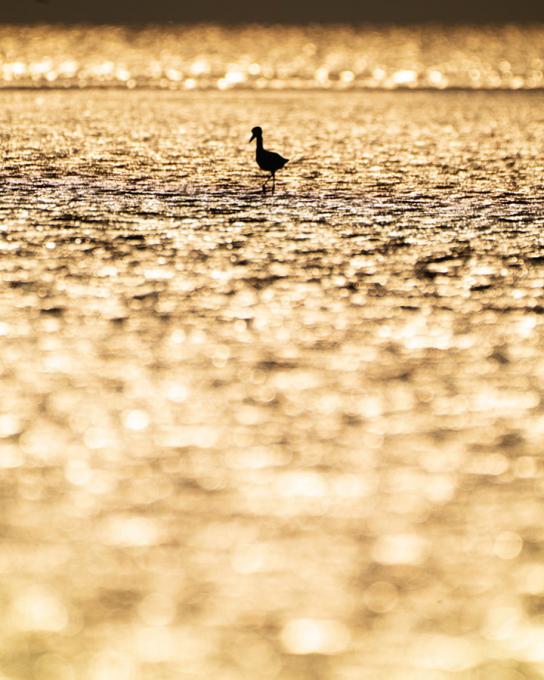 A crab-plover in the same area just before the sunset.. tried to play with the depth of field and kept the bird in a silhouette because I felt the golden light reflected around it will emphasis the importance of the bird..
A crab-plover in the same area just before the sunset.. tried to play with the depth of field and kept the bird in a silhouette because I felt the golden light reflected around it will emphasis the importance of the bird.. 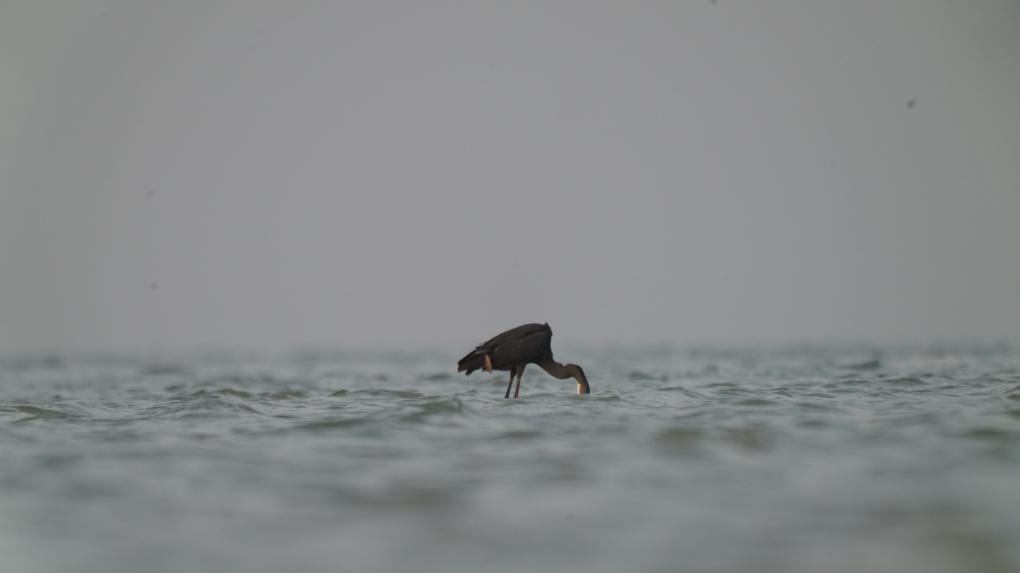 I went to a small island to photograph terns.. Got good photos.. but on my way back and just when I reached the shore of the mainland I noticed this Heron fishing.. decided to give it a try and lay down in the middle of the water.. started photographing.. and waited for around 13 minutes till the heron got his fish!
I went to a small island to photograph terns.. Got good photos.. but on my way back and just when I reached the shore of the mainland I noticed this Heron fishing.. decided to give it a try and lay down in the middle of the water.. started photographing.. and waited for around 13 minutes till the heron got his fish!

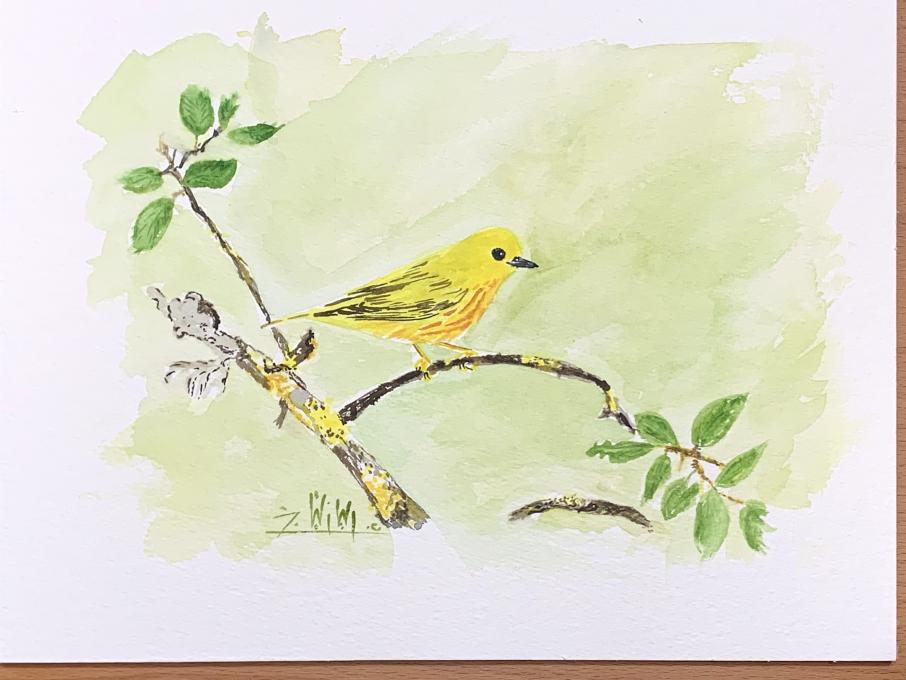 I did it at last! I tried to go over my fear from watercolours by taking an online course with Ms Molly Murrah "Watercolor 101;" this explains why I'm late ^_^;
I still like my first one.. but I feel satisfied with the 100% watercolour copy. Regardless of the mistakes in the painting style, this is my very first watercolour piece :)
I did it at last! I tried to go over my fear from watercolours by taking an online course with Ms Molly Murrah "Watercolor 101;" this explains why I'm late ^_^;
I still like my first one.. but I feel satisfied with the 100% watercolour copy. Regardless of the mistakes in the painting style, this is my very first watercolour piece :)

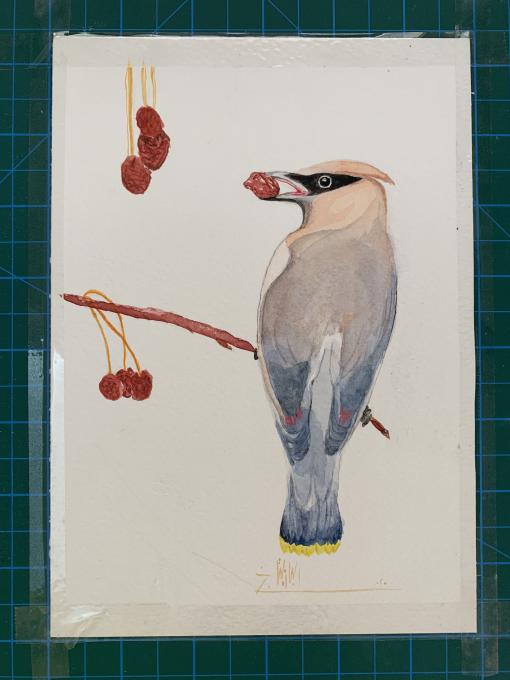 I posted before an attempt to paint a watercolour piece - BUT I spit water one it by mistake !
I didn't want to move forward without posting something here that I'm well satisfied with. So, I followed the video.
I lost control while using the water several times (I don't know why I lose it alway while brushing the right side!) The original plan was to paint the background, however, I forgot that and went straight forward to the bird. Didn't want to take the rest and ruin this piece too. I lost the side fruits as well >.>
I posted before an attempt to paint a watercolour piece - BUT I spit water one it by mistake !
I didn't want to move forward without posting something here that I'm well satisfied with. So, I followed the video.
I lost control while using the water several times (I don't know why I lose it alway while brushing the right side!) The original plan was to paint the background, however, I forgot that and went straight forward to the bird. Didn't want to take the rest and ruin this piece too. I lost the side fruits as well >.>
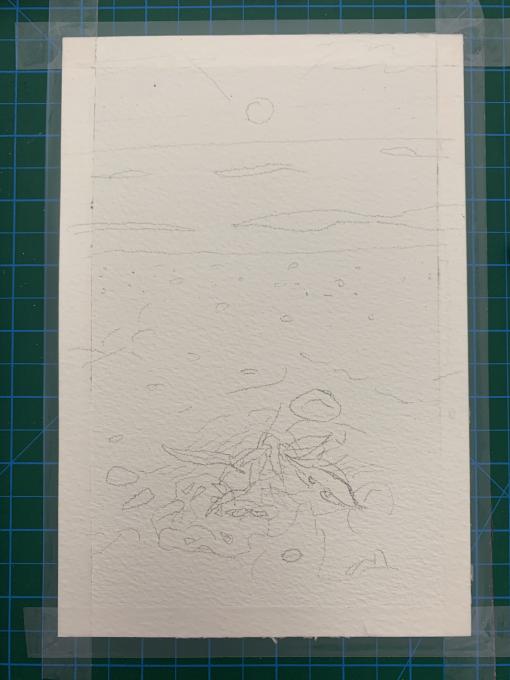
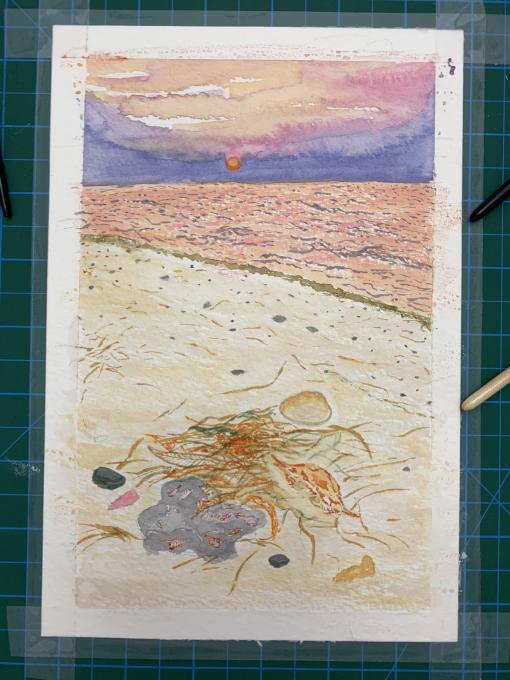
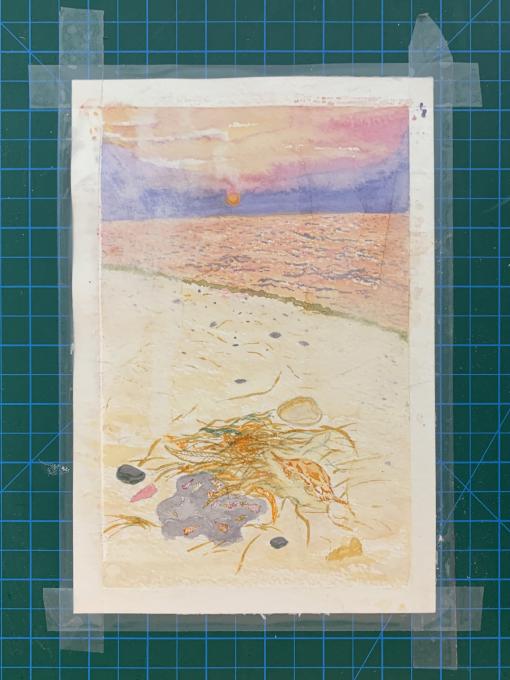
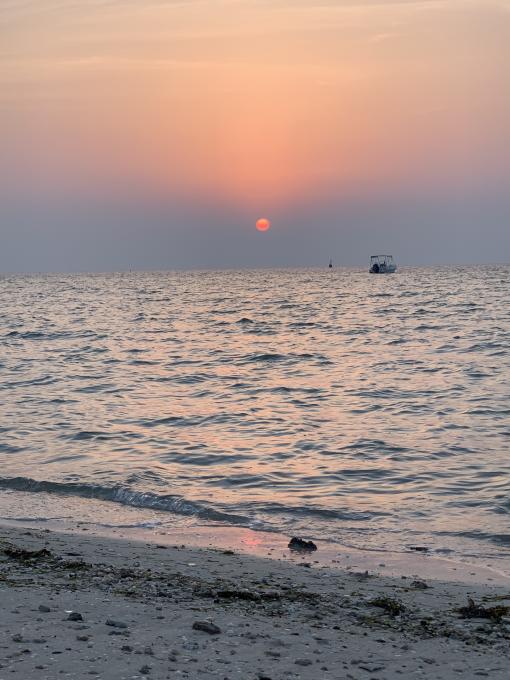
 When I went back inside to paint, I felt I need to create a reference sheet. I sticked with the basic colours only (I know I have ready colours but mixing colours has a much deeper feelings which I liked). The reference sheet was done - and just before that I lost my motive to paint, therefore, I left the sketch for the next morning.
When I went back inside to paint, I felt I need to create a reference sheet. I sticked with the basic colours only (I know I have ready colours but mixing colours has a much deeper feelings which I liked). The reference sheet was done - and just before that I lost my motive to paint, therefore, I left the sketch for the next morning.
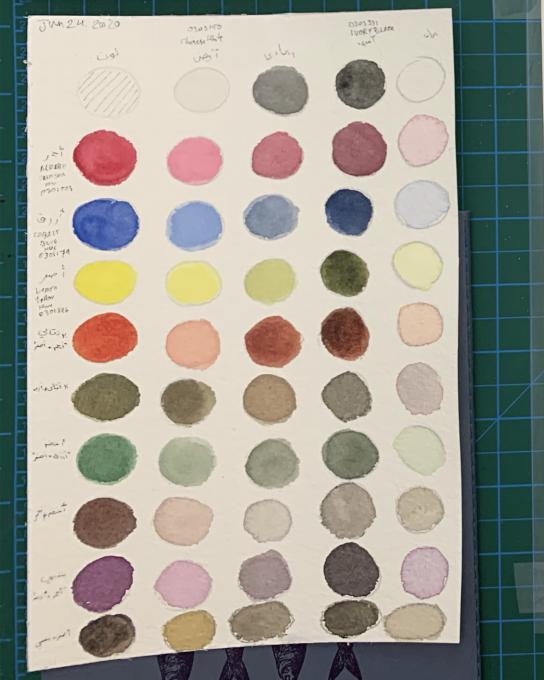
 While working on this entry, I was convinced with one thing: watercolour needs patience. To tame my urgency within myself, I have decided to sketch three sketches at the same time and paint them using watercolours only. By doing so, I was able to create layers for each sketch. After finishing a layer, I moved to the other sketch and do the same. This give me enough time to let the layer dry and experiment as well.
This is my first sketch:
While working on this entry, I was convinced with one thing: watercolour needs patience. To tame my urgency within myself, I have decided to sketch three sketches at the same time and paint them using watercolours only. By doing so, I was able to create layers for each sketch. After finishing a layer, I moved to the other sketch and do the same. This give me enough time to let the layer dry and experiment as well.
This is my first sketch:
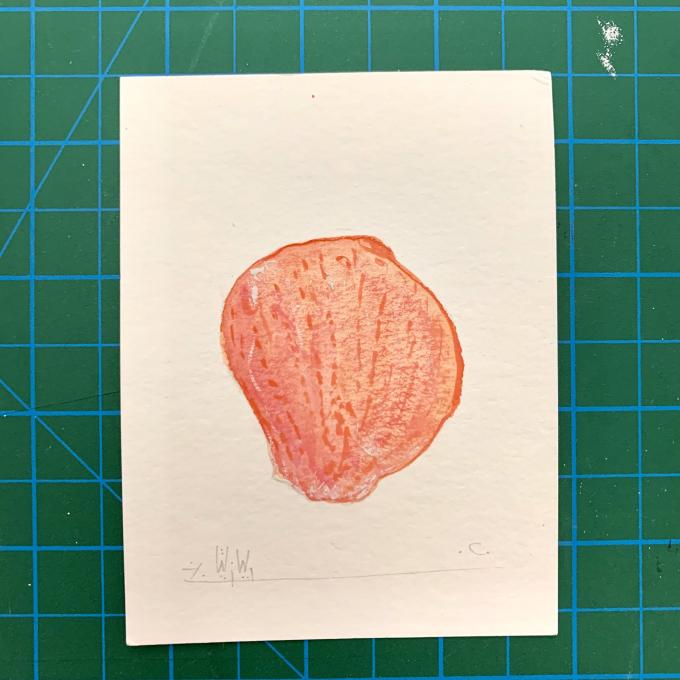 1. The pencil used for the outline sketch was a B6 pencil, I decided to erase it and use a watercolour grey pencil instead. The reason to do so was to avoid erasing any pencil marks after colouring the piece. I was afraid that the eraser would ruin the colours and the sheet.
2. I sticked with the main colours: red, yellow, & blue as well as the white and black. For the base, I mixed the colours on the palette. used a dry on wet for all the sketches.
3. As soon as I felt that the base is dry , I added a bit of lining with the tip of the brush to give an overall colour scheme for the background.
4. After that I waited until it dried fully. Then I used the dry brush to add the details to the texture.
5. I decided to use the white paste with no water at all on a semi-wet brush tip to add a depth to the texture.
6. I tried to add some shades & tones wherever needed as a final step.
This is the second piece:
1. The pencil used for the outline sketch was a B6 pencil, I decided to erase it and use a watercolour grey pencil instead. The reason to do so was to avoid erasing any pencil marks after colouring the piece. I was afraid that the eraser would ruin the colours and the sheet.
2. I sticked with the main colours: red, yellow, & blue as well as the white and black. For the base, I mixed the colours on the palette. used a dry on wet for all the sketches.
3. As soon as I felt that the base is dry , I added a bit of lining with the tip of the brush to give an overall colour scheme for the background.
4. After that I waited until it dried fully. Then I used the dry brush to add the details to the texture.
5. I decided to use the white paste with no water at all on a semi-wet brush tip to add a depth to the texture.
6. I tried to add some shades & tones wherever needed as a final step.
This is the second piece:
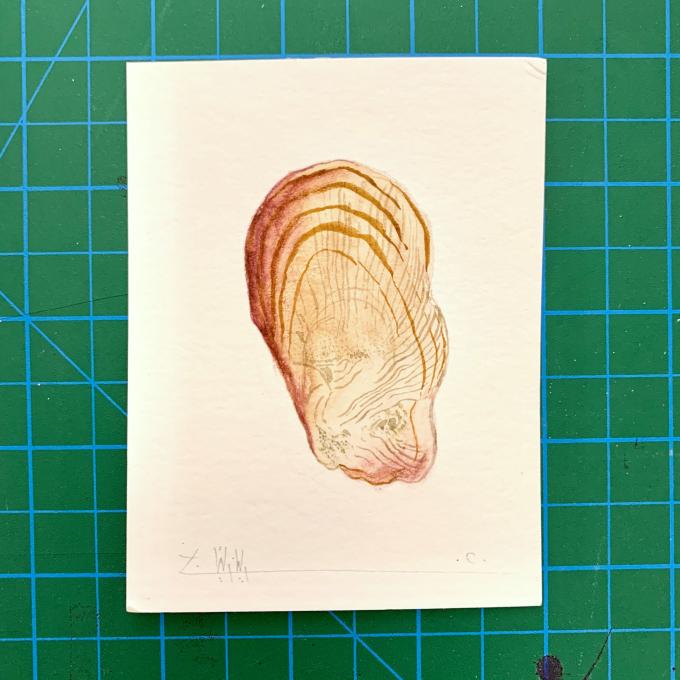 I can’t upload the third one. I did one deadly mistake - I was lazy to mix and find the colour I want for the final detail lining - I ruin it with a blue instead of a dark/grey-purple.
(I lost my patience at the last minute! >.> )
I can’t upload the third one. I did one deadly mistake - I was lazy to mix and find the colour I want for the final detail lining - I ruin it with a blue instead of a dark/grey-purple.
(I lost my patience at the last minute! >.> ) 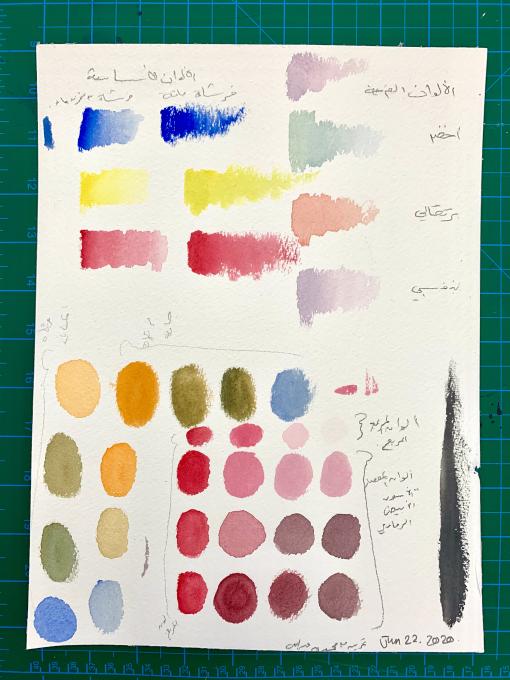
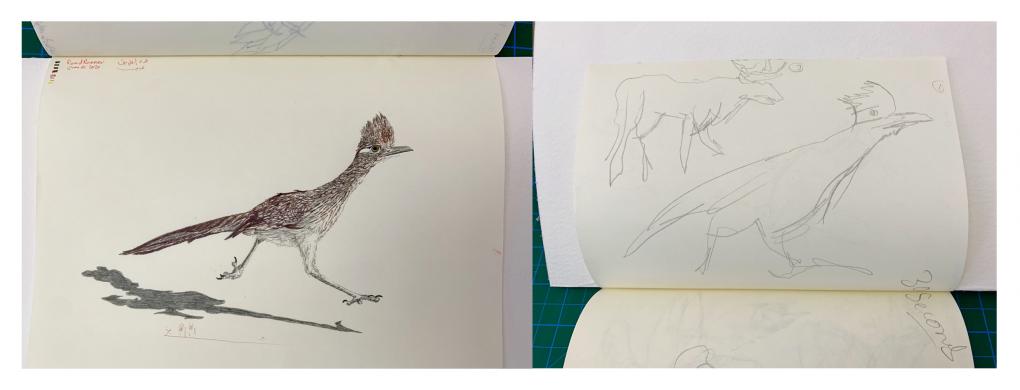 I wanted to compare how I looked at & sketched an image/subject in 30 seconds then how I looked at it and sketched it with an unlimited time (took me around an hour and a half to finish it). I think when I did the quick sketch the “feeling” of its speed was visible n the sketch’s crown, however, In reality it isn’t visible as much. I’m wondering now, how much do we add from our own memory and interpretation of a behaviour while sketching? If there was no photograph would I be able to sketch at such accuracy?
The most important and helpful technique was the measuring proportion and the lighting and shades. I used fine liner pens (0.05 & 0.1) for this sketch, which were 7 colours: Grey, Black, Dark Grey, Sepia, Bright Sepia, Red, Blue + a yellow coloured pencil for the eye.
I tried to be aware of other techniques while sketching but I couldn’t. I was thinking of looking at the overall subject without its details, but I’m not sure if i did it consciously or i missed - cause the moment I start sketching I went deep into and I lost track of techniques used!
This is the final image:
I wanted to compare how I looked at & sketched an image/subject in 30 seconds then how I looked at it and sketched it with an unlimited time (took me around an hour and a half to finish it). I think when I did the quick sketch the “feeling” of its speed was visible n the sketch’s crown, however, In reality it isn’t visible as much. I’m wondering now, how much do we add from our own memory and interpretation of a behaviour while sketching? If there was no photograph would I be able to sketch at such accuracy?
The most important and helpful technique was the measuring proportion and the lighting and shades. I used fine liner pens (0.05 & 0.1) for this sketch, which were 7 colours: Grey, Black, Dark Grey, Sepia, Bright Sepia, Red, Blue + a yellow coloured pencil for the eye.
I tried to be aware of other techniques while sketching but I couldn’t. I was thinking of looking at the overall subject without its details, but I’m not sure if i did it consciously or i missed - cause the moment I start sketching I went deep into and I lost track of techniques used!
This is the final image:

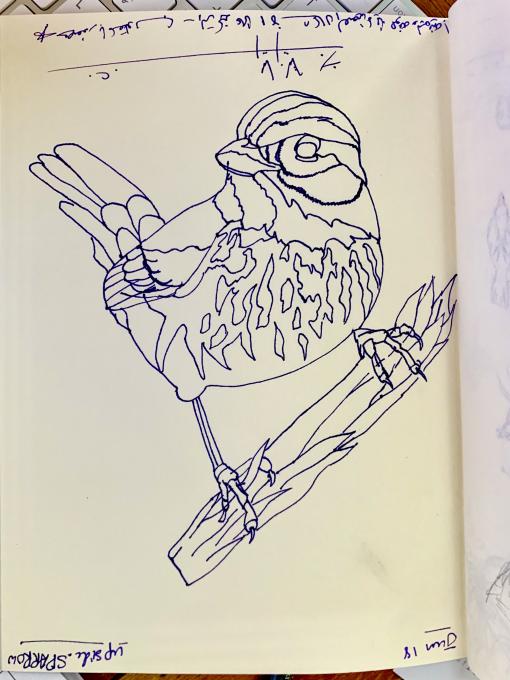 I tried to focus on the shapes and lines. The image of the bird kept on drifting me away from the exercise. It was challenging from that perspective. Apart of that I have enjoyed it - in fact, I was smiling all the way and when I signed it and flipped the notebook I was surprised! Loved it!
I tried to focus on the shapes and lines. The image of the bird kept on drifting me away from the exercise. It was challenging from that perspective. Apart of that I have enjoyed it - in fact, I was smiling all the way and when I signed it and flipped the notebook I was surprised! Loved it!  Away from the birds, I measured the proportion of my camera and its tele-lens. I used a pencil (I prefer ink though). The technique as a technique is very useful. It is very helpful for still-life and a subject that isn't moving much - not for fast birds. With time and practice the sight is being trained to measure without this technique; I rarely use it because I'm not that patient :/
- I'm here to train myself , I'll give it a try with future drawing. -
Away from the birds, I measured the proportion of my camera and its tele-lens. I used a pencil (I prefer ink though). The technique as a technique is very useful. It is very helpful for still-life and a subject that isn't moving much - not for fast birds. With time and practice the sight is being trained to measure without this technique; I rarely use it because I'm not that patient :/
- I'm here to train myself , I'll give it a try with future drawing. - 
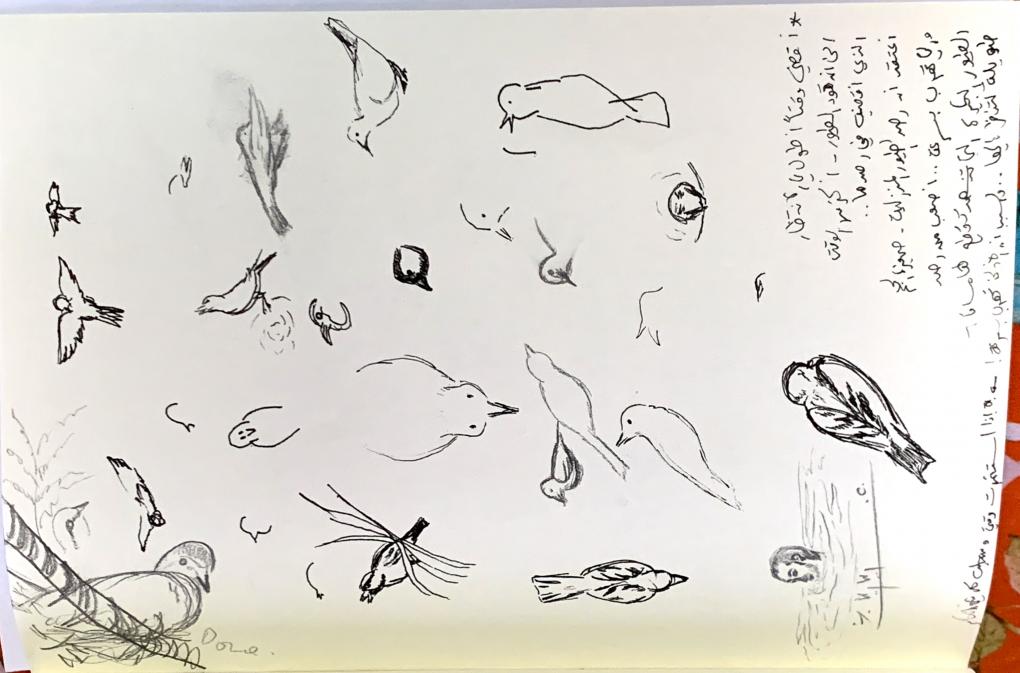 Gesture drawing did help me observing the birds -- Yet, they were too fast to be sketched. I kept my camera and phone away (cause I have this tendency of photographing and videoing the birds to be able to sketch them later) I forced myself to just sketch with my pen or pencil. I thought of sketching the shapes only - then I went deeper to observe each part of their anatomy. Their heads, their legs, their "closed" wings and "opened wings. I also was able to focus on their gestures while drinking water, specifically speaking, how their bodies' bend and how it rise while drinking. I've didn't give it much of thought before.
Luckily, I noticed a Dove in her nest above my head. There were lots of branches between us , but I tried to get her eye while looking at me :)
I have noticed the uniqueness of the house sparrows's black marks on its wings -- both males and females. I've never noticed / or better said / never thought of it until I was sketching their closed wings while standing.
Real-life sketching was a bit hard because they were flying away at the minimal movements. Also, they were far away and small in size, I believe this made me sketch tinny sketches :/
It just occurred to my mind that I tend to pick tinny small creatures to sketch.. I'll look for a much larger bird next!
Gesture drawing did help me observing the birds -- Yet, they were too fast to be sketched. I kept my camera and phone away (cause I have this tendency of photographing and videoing the birds to be able to sketch them later) I forced myself to just sketch with my pen or pencil. I thought of sketching the shapes only - then I went deeper to observe each part of their anatomy. Their heads, their legs, their "closed" wings and "opened wings. I also was able to focus on their gestures while drinking water, specifically speaking, how their bodies' bend and how it rise while drinking. I've didn't give it much of thought before.
Luckily, I noticed a Dove in her nest above my head. There were lots of branches between us , but I tried to get her eye while looking at me :)
I have noticed the uniqueness of the house sparrows's black marks on its wings -- both males and females. I've never noticed / or better said / never thought of it until I was sketching their closed wings while standing.
Real-life sketching was a bit hard because they were flying away at the minimal movements. Also, they were far away and small in size, I believe this made me sketch tinny sketches :/
It just occurred to my mind that I tend to pick tinny small creatures to sketch.. I'll look for a much larger bird next! 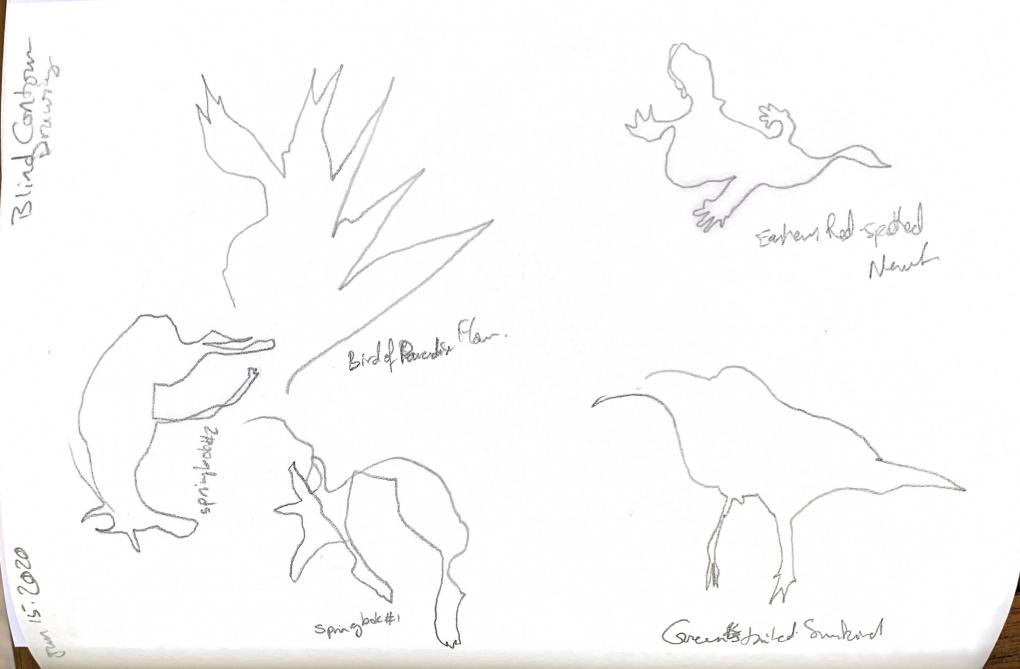 Found it an interesting exercise. With too images I missed to connect the shapes; Bird of Paradise Flower and the Green-tailed Sunbird. While with the Newt I had a mind gap -I just wasn't sure where was I- and the sketch ended up with a bubble booming out of it!
I was shocked because I completely missed with the Springbok (check #1) I thought it was easy and I doodled it with one line but it turned out to be a complete failure - couldn't accept that and so I re-sketched it with the blind contour technique and I think I did well :)
I didn't know how this would help me - However, it affected my mind while working on the next exercise. Also, this morning, I noticed my sight memorising and looking at the shape of the birds instead of the details. (usually I look at the details before the overall bird. So, I guess this will help and develop my sketching skills. )
Found it an interesting exercise. With too images I missed to connect the shapes; Bird of Paradise Flower and the Green-tailed Sunbird. While with the Newt I had a mind gap -I just wasn't sure where was I- and the sketch ended up with a bubble booming out of it!
I was shocked because I completely missed with the Springbok (check #1) I thought it was easy and I doodled it with one line but it turned out to be a complete failure - couldn't accept that and so I re-sketched it with the blind contour technique and I think I did well :)
I didn't know how this would help me - However, it affected my mind while working on the next exercise. Also, this morning, I noticed my sight memorising and looking at the shape of the birds instead of the details. (usually I look at the details before the overall bird. So, I guess this will help and develop my sketching skills. ) 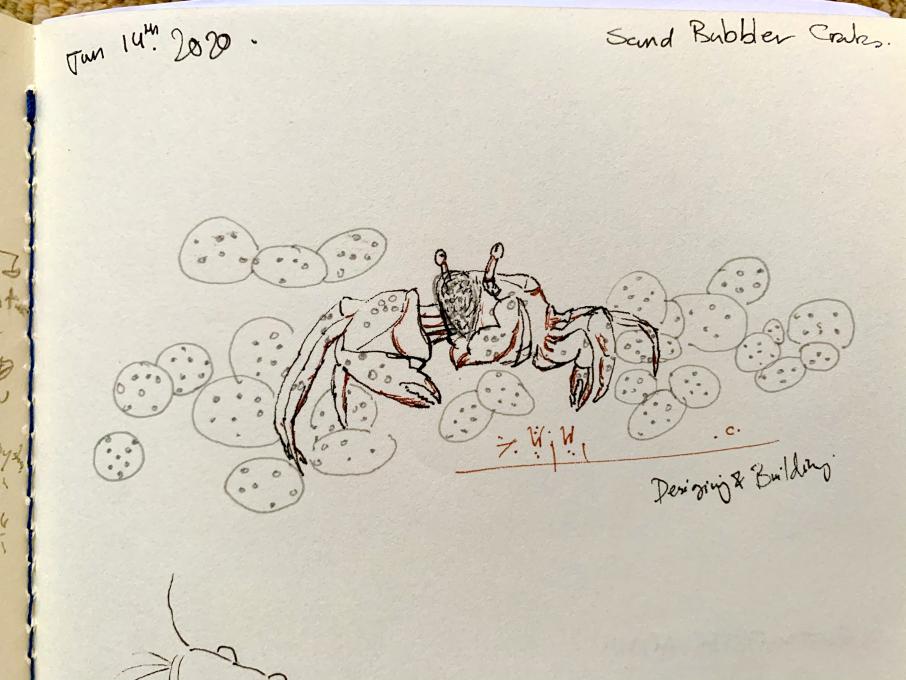 I went to observe the sand crabs - tinny creatures that will disappear with the any movement around it. So, you have to stay still for a bit more than 5 minutes for them to comeback and continue their pieces of art on the sand.
They appear when the tide is low. They are at the lowest level of the ecosystems, shore birds would eat them (I don’t know if the fishes does too but this makes me wonder where do they go when to seawater covers this area of the beach).
The create clean pretty forms in the ground with the beach sand. I was able to video several scenes while they are sucking the sand into their lower body whole then bubbling it out of their mouth creating mini-sand balls. They try to rearrange the sandballs by fixing them in lines with their back legs (Am I using the right word here?).
I went to observe the sand crabs - tinny creatures that will disappear with the any movement around it. So, you have to stay still for a bit more than 5 minutes for them to comeback and continue their pieces of art on the sand.
They appear when the tide is low. They are at the lowest level of the ecosystems, shore birds would eat them (I don’t know if the fishes does too but this makes me wonder where do they go when to seawater covers this area of the beach).
The create clean pretty forms in the ground with the beach sand. I was able to video several scenes while they are sucking the sand into their lower body whole then bubbling it out of their mouth creating mini-sand balls. They try to rearrange the sandballs by fixing them in lines with their back legs (Am I using the right word here?).
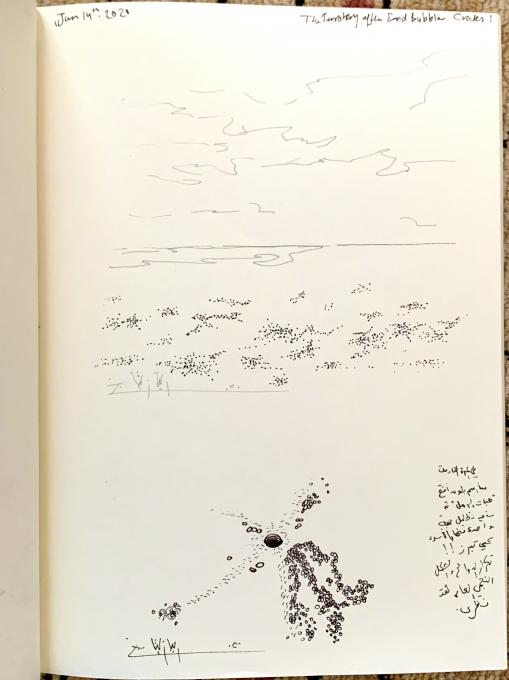 The upper part of the page has a wide scene of the beach; the sand balls looks amazing in reality. The lower part of the page has a close-up of one of the holes , the sand balls, the prints of the sand bubbler crab and the crab (owner of this in process piece of art).
While observing, sketching and videographing, lots of unanswered questions popped into my mind. Some of which are:
1) do they “see” with their eyes or do they sense the vibrations of any movement with their whole body? (They are too fast)
2) why do they form such shapes? Does the bubbled sand-balls has some liquid or smell that comes out of them while bubbling it?
3) is this an indicator of the crab’s territory? Or a mating sign?
4) what is the lifespan of the crab ? At which age(?) do they start designing these bubbled sand ?
5) when the tide is high, and when all their sand-balls are ruins where do they go ? Why do they insist on bubbling new sand-balls over and over and never give up?
6) if they can be pray of birds - doesn’t these sand-balls are clear marks of their existence ? (Bird-view wise they can be spotted easily!)
Guess I have to research it to find answers :)
The upper part of the page has a wide scene of the beach; the sand balls looks amazing in reality. The lower part of the page has a close-up of one of the holes , the sand balls, the prints of the sand bubbler crab and the crab (owner of this in process piece of art).
While observing, sketching and videographing, lots of unanswered questions popped into my mind. Some of which are:
1) do they “see” with their eyes or do they sense the vibrations of any movement with their whole body? (They are too fast)
2) why do they form such shapes? Does the bubbled sand-balls has some liquid or smell that comes out of them while bubbling it?
3) is this an indicator of the crab’s territory? Or a mating sign?
4) what is the lifespan of the crab ? At which age(?) do they start designing these bubbled sand ?
5) when the tide is high, and when all their sand-balls are ruins where do they go ? Why do they insist on bubbling new sand-balls over and over and never give up?
6) if they can be pray of birds - doesn’t these sand-balls are clear marks of their existence ? (Bird-view wise they can be spotted easily!)
Guess I have to research it to find answers :)  Then, I tried to sketch the first one and to give some sense of the environment around him. Shallow water, rocks and shells forming lines one before the heron and the other is far behind it. This framed the heron in the middle of lines ; sea, rocks , shallow water, then again the rocks and shells and the shallow water.
Then, I tried to sketch the first one and to give some sense of the environment around him. Shallow water, rocks and shells forming lines one before the heron and the other is far behind it. This framed the heron in the middle of lines ; sea, rocks , shallow water, then again the rocks and shells and the shallow water.
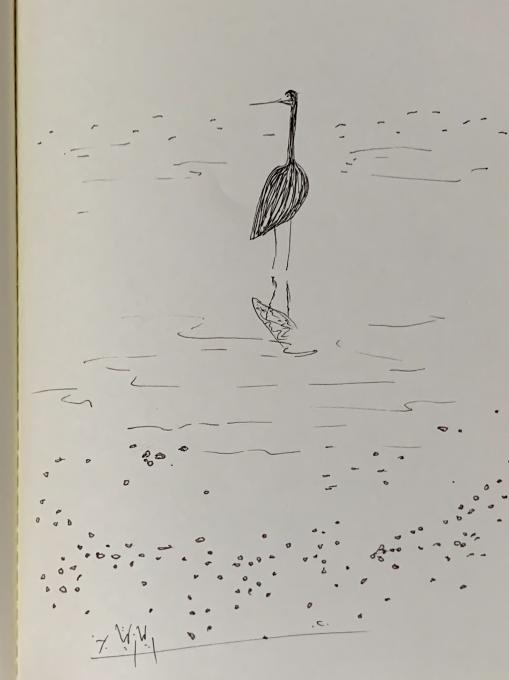 The sun was rising and the weather was getting humid, therefore, I decided to sketch the heron that I photographed several days ago in the same area. After sketching it quickly, I though there is a missing feeling between the quick sketches of the same bird and the final sketch from a photograph. Can you feel the difference too? I didn't write much -- I went back indoors quarter after 8 because the weather was getting warmer and warmer (I should've got myself an umbrella or some sort of shades (and a water!).
The sun was rising and the weather was getting humid, therefore, I decided to sketch the heron that I photographed several days ago in the same area. After sketching it quickly, I though there is a missing feeling between the quick sketches of the same bird and the final sketch from a photograph. Can you feel the difference too? I didn't write much -- I went back indoors quarter after 8 because the weather was getting warmer and warmer (I should've got myself an umbrella or some sort of shades (and a water!).
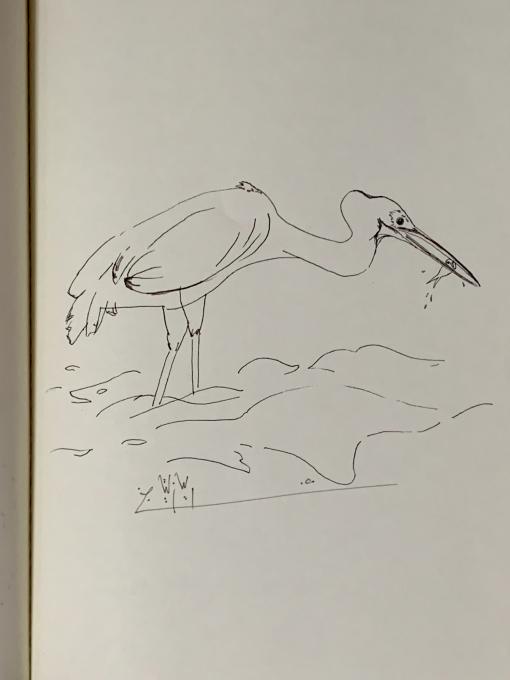 I'm planning to go there again and to sketch the tinny small red crabs that makes plenty of tinny small sand balls! I consider them to be the artists of the shore ; they form WOW shapes on the sand - worth observing!
I'm planning to go there again and to sketch the tinny small red crabs that makes plenty of tinny small sand balls! I consider them to be the artists of the shore ; they form WOW shapes on the sand - worth observing! 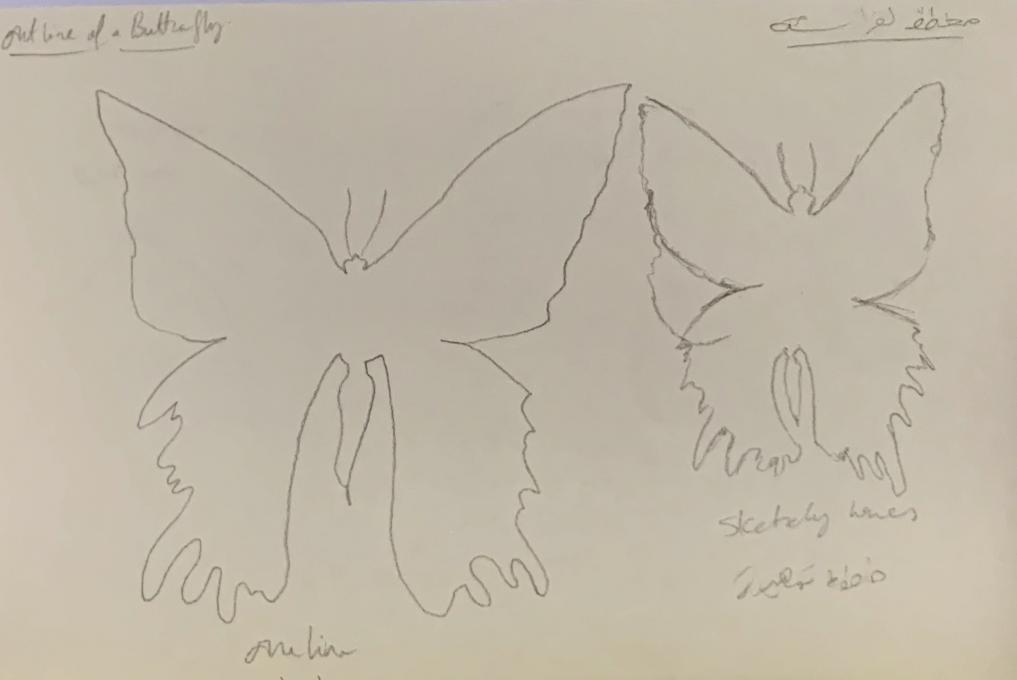 Sketching with a continuous one line gave me a sense of confidence. On the other hand, the sketchy lines technique hindered me; the more I sketch a new line the more I hesitant in visualising the shape I wish to sketch. I faced this problem while outlining all of the subjects: the daisy, the acorn, the gingko and the butterfly. Have you faced the same issue, anyone?
Sketching with a continuous one line gave me a sense of confidence. On the other hand, the sketchy lines technique hindered me; the more I sketch a new line the more I hesitant in visualising the shape I wish to sketch. I faced this problem while outlining all of the subjects: the daisy, the acorn, the gingko and the butterfly. Have you faced the same issue, anyone? With the type of marks in sketching -- I sketched a blue sea crab; luckily, I found a dried one. I divided it into 5 parts to experiment with the marks ' types. I'm sharing the result with you. I'm not sure if I did well with the marks -- I tend to use tinny tip of the fine-liner pens; 0.05 and 0.1. Perhaps I need to try and sketch with a thicker pens/pencils to see the difference.
With the type of marks in sketching -- I sketched a blue sea crab; luckily, I found a dried one. I divided it into 5 parts to experiment with the marks ' types. I'm sharing the result with you. I'm not sure if I did well with the marks -- I tend to use tinny tip of the fine-liner pens; 0.05 and 0.1. Perhaps I need to try and sketch with a thicker pens/pencils to see the difference.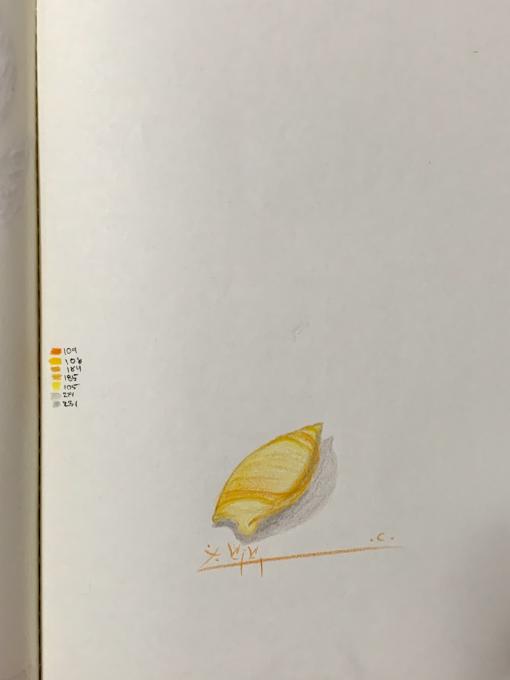 This is my attempt to try and look at the shades of a subject. I tried with this shell; Ancilla Glabrata. I used an artificial source of light instead of the sunlight - this shouldn't affect the result much but looking at the final result, I think if I was after the shades, then I should have tried to sketch it with one pencil colour.
This is my attempt to try and look at the shades of a subject. I tried with this shell; Ancilla Glabrata. I used an artificial source of light instead of the sunlight - this shouldn't affect the result much but looking at the final result, I think if I was after the shades, then I should have tried to sketch it with one pencil colour.